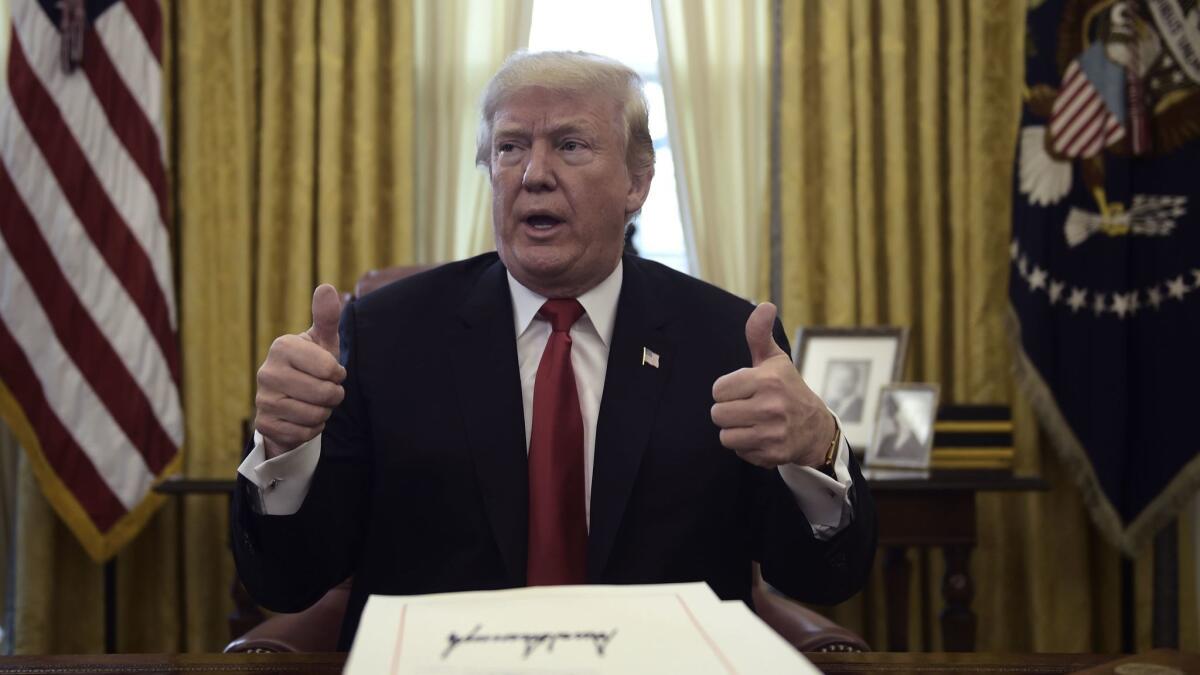Column: A devastating analysis of the tax cut shows it’s done virtually no economic good

You may remember all the glowing predictions made for the December 2017 tax cuts by congressional Republicans and the Trump administration: Wages would soar for the rank-and-file, corporate investments would surge, and the cuts would pay for themselves.
The nonpartisan Congressional Research Service has just published a deep dive into the economic impact of the cuts in their first year, and emerges from the water with a different picture. The CRS finds that the cuts have had virtually no effect on wages, haven’t contributed to a surge in investment, and haven’t come close to paying for themselves. Nor have they delivered a cut to the average taxpayer.
The negligible (at best) economic impact of the cuts shouldn’t surprise anyone, the CRS says. “Much of the tax cut was directed at businesses and higher-income individuals who are less likely to spend,” its analysts write. “Fiscal stimulus is limited in an economy that is at or near full employment.”
There is no indication of a surge in wages in 2018 either compared to history or relative to GDP growth. Ordinary workers had very little growth.
— Congressional Research Service
The CRS findings aren’t all that novel. The service, which is an arm of the Library of Congress, reports that the tax cuts contributed to a record-breaking surge in corporate stock buybacks, which has been documented by many other analyses. The continued stagnation of rank-and-file wages is visible in monthly data computed by the Bureau of Labor Statistics.
Furthermore, the GOP’s claims that the tax cuts would create an economic nirvana were discounted by most qualified economic observers from the start. (“These statements,” the CRS says innocently, “were not supported by most of the published analysis.”)
Let’s examine the Congressional Research Service report point by point.
The report addresses predictions that the cuts would pay for themselves in economic growth. These forecasts were based on the notion that business investment would surge because the lowered corporate tax rate (to 21% from 35%) would increase investment from abroad, including the repatriation of U.S. corporate assets from foreign subsidiaries that had been stowed overseas.
Among the big promoters of the idea were Larry Kudlow, President Trump’s chief economic advisor, and Stephen Moore, an economic commentator widely criticized as having a flawed grasp of economic reality.
The CRS says that the cuts produced an increase of 0.3% at most in gross domestic product in 2018. For the cuts to pay for themselves, an increase of more than 6.7% would be necessary. In other words, the report says, the cuts produced less than one-twentieth of the economic gain needed to pay for themselves.
The CRS also takes aim at claims from the Trump White House that tax revenues increased thanks to the cuts (i.e., that economic activity increased so much that more taxes were paid). The big promoter of this idea, again, is Kudlow, who has placed the increase at 10%.
Not so, the Congressional Research Service says. Overall revenue fell in 2018, largely because of a $40-billion decline in corporate tax revenue. Individuals, particularly working- and middle-class individuals, haven’t been so fortunate. Although the legislation increased the standard deduction and child credit, whatever tax reductions those would produce for families were “largely offset” by the elimination of personal exemptions, and limitations on itemized deductions such as those for state and local taxes.
Did the tax bill contribute to higher pay for the rank-and-file? The White House endowed the tax cuts with an almost magical capability to drive wages higher, estimating the result at anywhere from $4,000 to $9,000 a year per household. Those were long-term estimates, but even in the short term the administration predicted that workers would “immediately get a significant share (30%) of profits repatriated from abroad due to tax changes,” the CRS says.
Its analysis, however, knocks the legs out from under these projections: “There is no indication of a surge in wages in 2018 either compared to history or relative to GDP growth.” Real wages (that is, adjusted for inflation) increased by only 1.2% in 2018. “Ordinary workers had very little growth in wage rates.”
What may have obscured this dismal result was the spate of bonuses that big employers offered to workers, which was foolishly ascribed by some pundits (but not all) to the tax cuts. The CRS cites an estimate that the bonuses worked out to about $28 per U.S. worker. The analysts also observe that at least to some extent the bonuses reflected a tightening of the overall labor market and were “attributed to the tax cut as a public relations move.”
Corporate shareholders, however, have made out great. The repatriated earnings mostly have been used for “a record-breaking amount of stock buybacks, with $1 trillion announced by the end of 2018.” As the CRS notes tactlessly, the same phenomenon occurred in 2004, when a one-time tax holiday allowed companies to bring back earnings stashed abroad at a lower rate. That tax holiday had been promoted as a spur to investment and wage growth too. Never happened.
Indeed, government statistics show that shareholder dividends fairly exploded in the first quarter of 2018, immediately following the tax cut enactment, while reinvestments of those repatriated funds cratered. (Both figures returned to levels close to their historical averages soon afterward.)
The bottom line, then, is becoming clearer with every quarter. The tax cuts did almost nothing for ordinary Americans and may even have cost them money. The apparent gains in their income were negligible and short-lived. Wealthy Americans reaped the benefits of lower taxes and higher dividends. The cuts had a negligible effect on U.S. economic growth while depriving the government of revenue.
Put it all together and this massive restructuring of the U.S. tax system should prompt average Americans to ask Republicans in Congress and the White House that age-old question: Who are you really working for?
Keep up to date with Michael Hiltzik. Follow @hiltzikm on Twitter, see his Facebook page, or email michael.hiltzik@latimes.com.
Return to Michael Hiltzik’s blog.
More to Read
Inside the business of entertainment
The Wide Shot brings you news, analysis and insights on everything from streaming wars to production — and what it all means for the future.
You may occasionally receive promotional content from the Los Angeles Times.











